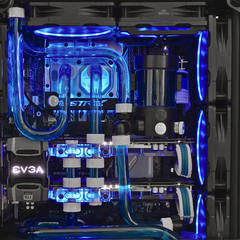
AriGee50
Member-
Posts
67 -
Joined
-
Last visited
Awards
This user doesn't have any awards
Profile Information
-
Gender
Female
-
Location
USA
-
Interests
umm...computers? ok and cars and fish tanks and drone photography (know why I want 16 threads now?) and rockets/space trave and anime and I do way too many things dont i...
System
-
CPU
Ryzen 7 1700X
-
Motherboard
Asus ROG STRIX X-370-F Gaming
-
RAM
32GB (4x8GB) G.Skill Trident Z RGB
-
GPU
EVGA 1070 Superclocked
-
Case
an Inwin monster
-
Storage
Samsung 970 Evo 500GB and 8 other drives...
-
PSU
Corsair RM1000i
-
Display(s)
27" Asus 1440p 144Hz primary and two 27" 1080p secondaries
-
Cooling
Corsair H115i
-
Keyboard
Corsair k65
-
Mouse
Razer Deathadder Chroma
-
Sound
Klipsh Promedia 2.1, Topping D30 DAC, Topping A30 Headphone amp, Fostex TH-X00 Headphones
-
Operating System
Windows 10 Pro
- PCPartPicker URL
Recent Profile Visitors
AriGee50's Achievements
-
So i have looked around and seen so many answers to this. Some say to enable it, some say to disable. Then things changed with later BIOS revisions and still some said to disable, some said to enable, sometimes for different reasons this time. Some say to set the skew amount to a certain number, but with some Asus BIOS you cant set that number (even though this is technically a "Strix" mobo, I dont have all of the BIOS options of the higher end Strix boards...wish I could have known that before hand...). So now, in 2019, what is the final say? Enable SenseMI? Disable it? Maybe it no longer matters at all? Ive gotten a stable 4.0 Ghz overclock on my 1700X with it disabled but I dont know if maybe I could get to a better OC by changing things. And also its just driving me nuts not knowing lol. Thanks everyone!
-
that doesnt seem to be what the HWinfo site says "Hence a new approach needs to be used called the Effective clock. This method relies on hardware's capability to sample the actual clock state (all its levels) across a certain interval, including sleeping (halted) states. The software then queries the counter over a specific polling period, which provides the average value of all clock states that occurred in the given interval. HWiNFO v6.13-3955 Beta introduces reporting of this clock." It seems like its actually polling that number, not merely calculating it. Thoughts?
-
So Im trying to rebuild my super stable 4.0 Ghz OC. After upgrading the BIOS, and of course, forgetting that doing so will reset all of the BIOS settings...Im now at it again trying to get my bloody OC back! So, on my way to getting everything sorted, and keeping a close eye on things in HWinfo, I noticed the "Core Effective Clock" readouts. Now I cant remember what these were doing in my last OC, I cant be sure, but certainly, this time, they are definitely jumping all over the place. Now its my understanding that the minute you set a non standard core multiplier, all dynamic core underclocking/undervolting stops. And yet, the "Effective Clock" will jump anywhere from the actual max clock (3991 MHz) while testing in Prime95 to 36 MHz at idle. So whats going on here. I looked up what Effective Clock means on HWinfo's site, but it didnt tell me a lot, and if anything made me worry more. Am I worrying about nothing? Are my clocks actually being dynamically changed even though they should be locked because of a non-stock multiplier setting? Thanks everyone! Ari
-
So I think this belongs better here than cooling since it really has to do with CPU behavior and not cooling. The cooling is working perfectly normally, as you can probably see from the graph. So really, this is just about CPU (or CPU/software) but not the cooling. (TL;DR in bold) So. I do a lot of folding. Any time Im not using my computer, if Im off at work or sleeping or w/e, the computer is folding all the time. At all of these times, CPU usage is pegged at 100%. And most of the time its fine, CPU sits right around 76 C usually, GPU sits right around 65 C, and all is right with the world. However, Ive done some datalogging of everything thats going on in HWInfo a few times, and ive noticed this very weird behavior. Every once in a while, CPU temps will spike to as high as 84 C. Its completely random, it can happen twice in ten minutes, or not at all in 8 hours, and its not a logging/reporting glitch because the temp does actually go back down gradually. It doesnt happen all that frequently, usually only 2-3 times in an 8 hour overnight run at most, but it can be less or more. This is a Ryzen 1700X OCed to 4.0 GHz on all 8. Cooler is a Corsair H115i (280mm rad). Ive included a graph of temp logged over time, the temp scale is very small, just 70-85 C. The time shown is right around 3 hours. It actually doesnt usually happen this frequently, but I thought it was a good example in a single graph. What do you guys think? What the dukes could cause this? Thanks everyone, Ariana (Also, a mod moved this to AIR COOLING? umm...theres no air cooling involved...so I moved it because that makes zero fucking sense...)
-
81*C too high for Ryzen 1700X?
AriGee50 replied to AriGee50's topic in Custom Loop and Exotic Cooling
all that info was in the original post. 1700X at 4.0 GHz on all 8 cores using a corsair H115i 280mm cooler. -
81*C too high for Ryzen 1700X?
AriGee50 replied to AriGee50's topic in Custom Loop and Exotic Cooling
using Arctic MX-4 which is a pretty good compound (with a good application. I even checked and redid it anyway). 81 C was definitely at full load (81 at idle would be...ridiuclous...). And really isnt all that crazy for a very heavily overclocked 1700X -
81*C too high for Ryzen 1700X?
AriGee50 replied to AriGee50's topic in Custom Loop and Exotic Cooling
I had. before I switched the radiator to intake air (when I was hitting 81 C) my fans were running at 100%. Which is 2500 rpm...it sounded like a 747 at takeoff...but I still left them at 100%. -
81*C too high for Ryzen 1700X?
AriGee50 replied to AriGee50's topic in Custom Loop and Exotic Cooling
yea its a 280mm rad. its a pretty hefty puppy. but even though the fan layout is a little goofy, my temps with the rad intaking air arent bad. the card has to work a little harder to stay cool but its not like it cant. I never hit higher than 65c on the card at 100% load on both CPU and GPU even at 2056 MHz on a 1070 so thats not bad. -
81*C too high for Ryzen 1700X?
AriGee50 replied to AriGee50's topic in Custom Loop and Exotic Cooling
not sure which "side" youre referring to, but this is the only place it can go. the case is too large for the hoses to reach the front of the case (and I would have to remove all 5 internal drives, which was half of the point of a case this big), its too large for the hoses to reach the bottom, it certainly couldnt go at the back, and I dont want to cut a hole in the acrylic panel for viewing, i think it would look terrible and while Im handy with a dremel, im not an artist either (well, not with my hands anyway...) and im never going to get it to look clean enough to be presentable, even if I did, I wouldnt like the aesthetic of having a giant radiator in front of all of the components I put a lot of time, effort and money into looking nice. -
81*C too high for Ryzen 1700X?
AriGee50 replied to AriGee50's topic in Custom Loop and Exotic Cooling
Yes, of course it has an attached fan, and yes, certainly pulling cold air through it as opposed to warm air makes a big difference. in fact, since i turned those fans around and had them pull air in from the top of the case, my temps went from about 80-81 with fans at 2400 rpm to 73-74 with fans at 1100 rpm. I wish i could put it on the back of the case, but it is not a small radiator, its a 280mm radiator...theres no way. even if there were room in the case, the graphics cards will be in the way. True, but i have seen tons and tons of people do a top mounted radiator that is exhausting air and therefor pulling warm air from inside the case, I am far from the only one who does this. But as I said, I have switched around the fans on the top so that they pull cold air in from the top of the case instead of exhaust. it isnt ideal because I now have a single exhaust fan but Im not sure what else to do. at least this way the CPU stays cool. the gpu has to work harder to stay cool but it can still be done relatively easily. - Explicitly specify Tdie or Tctrl Tdie - Which program you use to monitor the temperature (personal recommendation HWinfo64) HWinfo64 - Ambient room temperature about 23-24C - If liquid cooling, fluid temperature once saturated, about 41C while exhausting hot air, about 38C drawing in cool air - Vcore under "heavy load" (if appropriate, Vcore specified vs Vcore obtained and the LLC level) 1.356v, specified and obtained, no Vdroop at all (because LLC: 5) - Specify what "heavy load" is, time duration, and version number (E.g. Realbench (ver 2.56) stress test after 30 mins) I have used a number of tests, but the metric I use most frequently is folding@home, I know it is not a stress test per se, but it is the real world very difficult load it will actually be functioning on regularly (and actually gives higher temps than aida64). and this is after hours of running it. (3-8 hours) - Whether you are P-state overclocking or not no P-states Other useful peripheral information - Motherboard and BIOS revision number Asus Strix X370-F bios 4207 - Base clock & multiplier 100 x 40.0 - Voltage method (manual, offset, auto, etc) manual (1.356v) - GPU model and cooler style GTX 1070 at 2077 MHz, dual fan open air style - Case and case fans InWin GR One, mix of a lot of different fans, most of which suck ass, except the fans on the rad which only kind of suck ass (they move air like hell but theyre loud af) see the pic of the case above to see fans and placement hopefully that will help As I said, I think im going to keep this setup of drawing air in from the top of the case. its not ideal but I think it is the better alternative. and I will keep thinking about what to do next. -
81*C too high for Ryzen 1700X?
AriGee50 replied to AriGee50's topic in Custom Loop and Exotic Cooling
cant really, the radiator is on the top, and while I can do a little modding to get a third fan up there, because of the way the shroud on the top of the case is, I would just end up with exhausting air which would just get sucked right back into the radiator... Here is a diagram I made for another thread I have on the forum. The fan Im talking about could go to the right of the rad up top, but as you can see, with that shroud the way it is, that air is just going to end up going straight into the intake for the rad... -
Fan Configuration With Air and Water Cooled Setup
AriGee50 replied to AriGee50's topic in Custom Loop and Exotic Cooling
ahhh...ive thought about it. ive done it with other cases...but I just love this case so much and I love its aesthetic...I would hate to mod it in a way that disrupts that. I am a vain bitch at the end of the day and I want everything to be pretty lol. there is a fan mount on the rear panel, under the CPU socket but it would need a very low profile fan. not sure if it would realistically help case temps any, might help keep the socket cool but it doesnt seem like I have many problems with that (that said I dont have temp probes on the back of the mobo so i cant say that for sure). i dunno...still trying to come up with ideas... -
81*C too high for Ryzen 1700X?
AriGee50 replied to AriGee50's topic in Custom Loop and Exotic Cooling
at stock temps are much lower. I dont remember what exactly, but its significantly lower. even if I put all 8 cores at 3.8 instead of 4.0 its a lot cooler (i can run a pretty low voltage to get 3.8). Now ambient temp in my case is way higher than 23C so its not even possible for my chip to go that low. Hell, ambient in the room is about 24C so... Ambient inside the case is about 28C at its lowest, usually a little higher, so intaking air from inside the case, theres no way I can get coolant below 28. I did switch the radiator to intake air from the top of the case. now I dont like this setup much because it means I have one exhaust fan and 6 intake fans...but at least CPU temps are considerably lower, about 74 under full load, and thats with the fans on the rad running at 50%! which is crazy to me...my rad fans not sounding like a 747 at take off? crazy talk... So thats good, even still, coolant gets down to like 32-33 at the lowest. Unfortunately, my GPU has to pay the price. its only running 5C hotter than it used to, but my GPU fans are running at 80-85% to keep it there, before they could stay right about 60% to stay at 60C. so, not sure what to do...but at least for the moment ive gotten things a little more reasonable.







